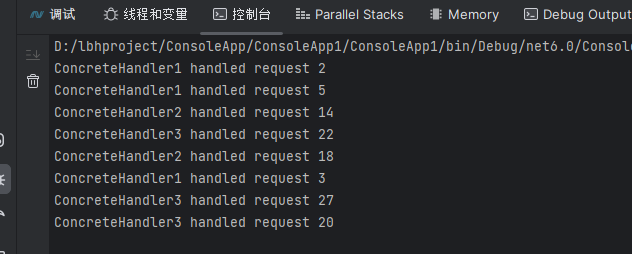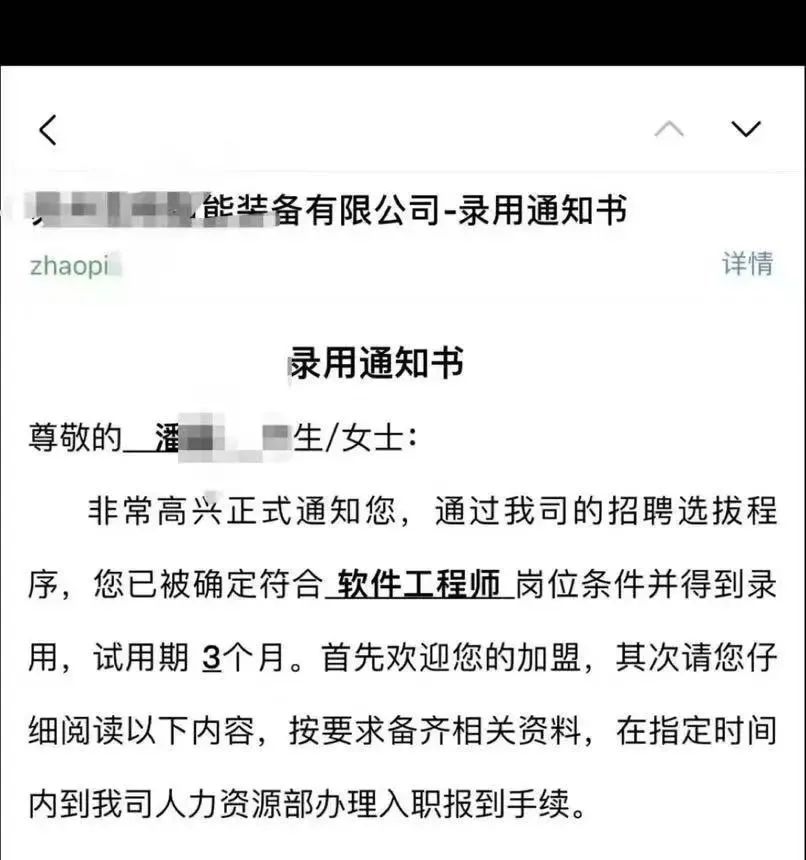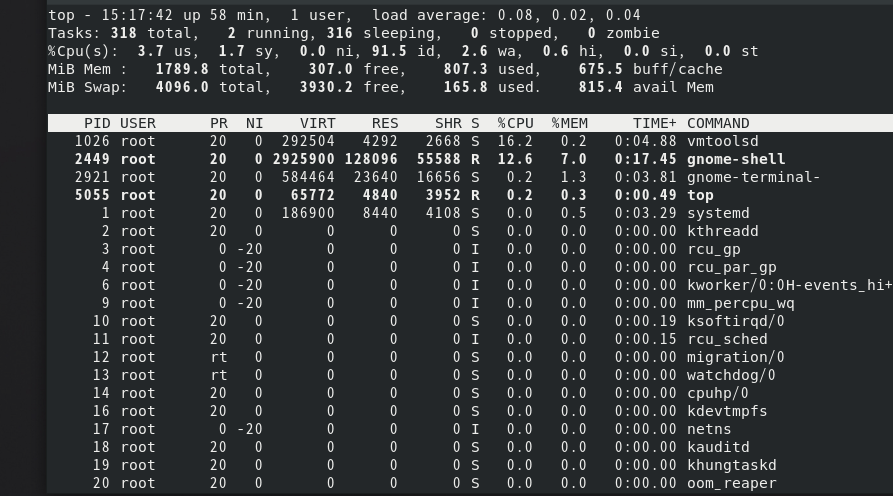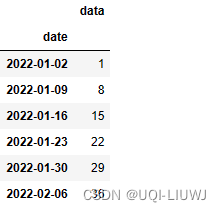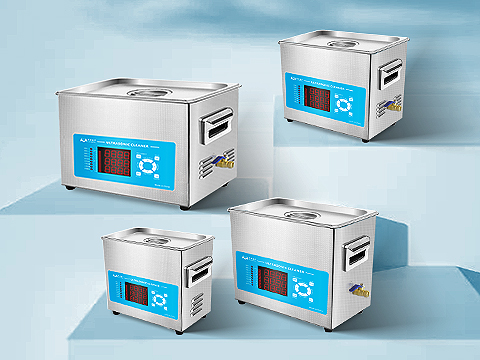强化学习环境 - robogym - 学习 - 3
文章目录
- 强化学习环境 - robogym - 学习 - 3
- 项目地址
- 为什么选择 robogym
- Observation - 观测信息
- Action - 动作信息
- Initialization - 初始状态设置
项目地址
https://github.com/openai/robogym
为什么选择 robogym
-
自己的项目需要做一些机械臂 table-top 级的多任务操作
-
robogym 基于 mujoco 搭建,构建了一个仿真机械臂桌面物体操作(pick-place、stack、rearrange)场景
-
robogym 的例程效果看,支持多个相机示教,包括眼在手上和眼在手外,可以获取多视角视觉信息
-
robogym 的物体支持 YCB 数据集格式
主要是这些原因,当然,看官方 readme.md 文档,它还有其他不错的功能。
国内主流社区对 robogym 的介绍比较少,所以选择写一些文档记录一下,作为参考。
Observation - 观测信息
robogym 的观测一般通过 obs = env.reset() 返回即可得到。爬源码可得到 obs 是一个字典。
把字典的键排序按照值的方法进行了简答的分类,可以得到:仿真环境的 obs 字典是通过:self.mujoco_simulation 、 robot_obs 、 self._goal 、 self._goal_info_dict 和 np.array 四个变量得到的。
obs = {
# 读取 self.mujoco_simulation 内部的方法返回作为值
"obj_pos": self.mujoco_simulation.get_object_pos(),
"obj_rel_pos": self.mujoco_simulation.get_object_rel_pos(),
"obj_vel_pos": self.mujoco_simulation.get_object_vel_pos(),
"obj_rot": self.mujoco_simulation.get_object_rot(),
"obj_vel_rot": self.mujoco_simulation.get_object_vel_rot(),
"qpos": self.mujoco_simulation.qpos,
"obj_gripper_contact": self.mujoco_simulation.get_object_gripper_contact(),
"obj_bbox_size": self.mujoco_simulation.get_object_bounding_box_sizes(),
"obj_colors": self.mujoco_simulation.get_object_colors(),
# 在代码上面实例化了
# robot_obs = self.mujoco_simulation.robot.observe()
# 这个实例,这部分的键对应的值就是 robot_obs 的方法
"robot_joint_pos": robot_obs.joint_positions(),
"gripper_pos": robot_obs.tcp_xyz(),
"gripper_velp": robot_obs.tcp_vel(),
"gripper_controls": robot_obs.gripper_controls(),
"gripper_qpos": robot_obs.gripper_qpos(),
"gripper_vel": robot_obs.gripper_vel(),
"tcp_force": robot_obs.tcp_force(),
"tcp_torque": robot_obs.tcp_torque(),
# self._goal 从源码来看就是每个物体重排列的位置。
"qpos_goal": self._goal["qpos_goal"].copy(),
"goal_obj_pos": self._goal["obj_pos"].copy(),
"goal_obj_rot": self._goal["obj_rot"].copy(),
"rel_goal_obj_pos": self._goal_info_dict["rel_goal_obj_pos"].copy(),
"rel_goal_obj_rot": self._goal_info_dict["rel_goal_obj_rot"].copy(),
"is_goal_achieved": np.array([self._is_goal_achieved], np.int32),
"safety_stop": np.array([robot_obs.is_in_safety_stop()]),
}
这里列出了每个键对应的含义。
| observation 键名 | 每个键的意义 |
|---|---|
| object_pos | Get position for all objects. |
| object_rel_pos | Get position for all objects relative to the gripper position. |
| object_vel_pos | Get position velocity for all objects relative to tooltip velocity. |
| object_rot | Get rotation in euler angles for all objects. |
| object_vel_rot | Get rotation velocity for all objects. |
| robot_joint_pos | Array of joint angles (one for each joint). |
| gripper_pos | Tooltip position in the Cartesian coordinate space. |
| gripper_velp | Tooltip velocity in the Cartesian coordinate space. |
| gripper_controls | Gripper’s linear target position. |
| gripper_qpos | Gripper joint positions. |
| gripper_vel | Gripper joint velocities. |
| qpos | Copy of full sim qpos including 3D-position and 4D-quaternion. |
| qpos_goal | Copy of full sim goal qpos including 3D-position and 4D-quaternion. |
| goal_obj_pos | Get current-goal positions for all objects. |
| goal_obj_rot | Get current-goal rotations in euler angles for all objects. |
| is_goal_achieved | Return if current goal is achieved. |
| rel_goal_obj_pos | Get current-goal positions for all objects relative to the gripper position. |
| rel_goal_obj_rot | Get current-goal rotations for all objects relative to the gripper position. |
| obj_gripper_contact | A numpy array of shape [num objects, len(other_geom_ids)], in which each value is binary, 1 meaning having contact and 0 no contact. |
| obj_bbox_size | Returns the bounding box for one objects as a tuple of (positive, half size), where both positive and half size are np.array of shape (3,). |
| obj_colors | This logic works, assuming only assign a single color to one object. |
| safety_stop | True if the arm is in a safety stop, False otherwise. |
| tcp_force | TCP force in world coordinates. |
| tcp_torque | TCP torque in world coordinates. |
根据自己的项目,选择:
object_pos、object_rot,代表了每个物体的位置和姿态;gripper_pos、gripper_controls,代表了机械臂的位置和张开闭合程度;goal_obj_pos、goal_obj_rot,代表了每个物体的目标位置和目标姿态。
需要精简一下观测的信息,有三种思路:
-
爬源码,把不必要的观测信息直接注释掉;
【注意】 一些项目中会在
observation生成后再对里面的键做处理,这样做会导致一些bug!! -
利用 Open AI Gym 的
FilterObservation()这个类过滤掉不想要的键; -
自己写一个函数,把不必要的键过滤掉;
【注意】
.reset()和.step()的返回都需要进行这样的操作!!
这里我选择自己写一个函数。
# create a small util to filter the observation
def filter_obs(raw_obs: dict, name_list: list) -> dict:
result = {}
for name in name_list:
result[name] = copy.copy(raw_obs[name])
return result
最后的代码如下。选择 pprint.pprint() 进行输出可以更加格式化。
import copy
import pprint
from robogym.envs.rearrange.ycb import make_env
# create a small util to filter the observation
def filter_obs(raw_obs: dict, name_list: list) -> dict:
result = {}
for name in name_list:
result[name] = copy.copy(raw_obs[name])
return result
# Create an environment with the default number of objects: 5
env = make_env(
parameters={
'simulation_params': {
'num_objects': 3,
'max_num_objects': 8,
}
}
)
# Reset to randomly generate an environment with `num_objects: 3`
obs = env.reset()
obs = filter_obs(obs, ["obj_pos", "obj_rot", "gripper_pos", "gripper_controls", "goal_obj_pos", "goal_obj_rot"])
pprint.pprint(obs)
while True:
a = env.action_space.sample()
next_obs, reward, done, info = env.step(a)
next_obs = filter_obs(next_obs, ["obj_pos", "obj_rot", "gripper_pos", "gripper_controls", "goal_obj_pos", "goal_obj_rot"])
pprint.pprint(next_obs)
env.render()
得到结果:
{'goal_obj_pos': array([[1.39363232, 0.86174547, 0.51221652],
[1.57460708, 0.70375038, 0.50919097],
[1.20793525, 0.8834796 , 0.49350575],
[0. , 0. , 0. ],
[0. , 0. , 0. ],
[0. , 0. , 0. ],
[0. , 0. , 0. ],
[0. , 0. , 0. ]]),
'goal_obj_rot': array([[ 0. , 0. , -1.79725862],
[ 0. , 0. , -1.13518178],
[ 0. , 0. , -2.40479252],
[ 0. , 0. , 0. ],
[ 0. , 0. , 0. ],
[ 0. , 0. , 0. ],
[ 0. , 0. , 0. ],
[ 0. , 0. , 0. ]]),
'gripper_controls': array([0.]),
'gripper_pos': array([1.23887261, 0.43994768, 0.68622718]),
'obj_pos': array([[1.59604171, 0.81327296, 0.51217642],
[1.57460711, 0.41286039, 0.50922118],
[1.40990736, 0.64130153, 0.49354594],
[0. , 0. , 0. ],
[0. , 0. , 0. ],
[0. , 0. , 0. ],
[0. , 0. , 0. ],
[0. , 0. , 0. ]]),
'obj_rot': array([[-8.89659174e-05, -7.47313090e-05, -1.79530140e+00],
[-3.00692282e-06, 4.73572520e-06, -1.13518163e+00],
[-4.85122664e-02, -4.51887581e-02, -2.40575071e+00],
[ 0.00000000e+00, 0.00000000e+00, 0.00000000e+00],
[ 0.00000000e+00, 0.00000000e+00, 0.00000000e+00],
[ 0.00000000e+00, 0.00000000e+00, 0.00000000e+00],
[ 0.00000000e+00, 0.00000000e+00, 0.00000000e+00],
[ 0.00000000e+00, 0.00000000e+00, 0.00000000e+00]])}
为什么 'goal_obj_rot' 这部分只有第三个元素有数值,前面两个没数值?
原因是这是用 rpy 格式描述姿态的。这三个元素依次表示roll 、 pitch 和 yaw 角。如下图所示。

而 table-top 级的物体都是“平躺”的,所以默认 yaw 角有姿态。
在上述打印出来的字典可以看到,当忽略很小的小数(-3.00692282e-06)时,目标姿态和当前物体姿态差别不大,这说明在当前环境中,只需要机械臂做细致的平移就行。
Action - 动作信息
robogym 的动作空间比较特殊:它通过一层 wrapper 把原本
[
−
1
,
1
]
[-1,1]
[−1,1] 数值的动作空间给离散化了:在 ~/robogym/robogym/wrappers/utils.py 里面 DiscretizeActionWrapper 把奖励值做了封装,通过离散数值索引一个列表 [-1. -0.8 -0.6 -0.4 -0.2 0. 0.2 0.4 0.6 0.8 1. ] ,获得机械臂TCP末端的偏移量,前面三维度分别是 xyz,后面两个维度是姿态角,最后一个维度是夹爪的开闭(但是测试效果是夹爪开闭似乎无效,可能是因为这是 rearrange 环境,对物体的操作更多是“push”而不是“pick-and-place”)。
【注意】在这样的默认包装下,保持机械臂末端位姿不动的动作向量是:a = np.asarray([5, 5, 5, 5, 5, 5]) 可以设置一个全局参数保存这个动作向量。
【注意】a = np.asarray([0, 0, 0, 0, 0, 0]) 不是静止的向量,相反,它是偏移最大的动作向量!
Initialization - 初始状态设置
好的初始状态既能完成更好的实验,也能在做成视频的时候更美观些。对于机械臂 rearrange 环境,设置初始状态的函数是在 ~/robogym/robogym/envs/rearrange/common/base.py 文件里面 RearrangeEnv 类的 _randomize_robot_initial_position() 函数中。函数中是通过设置末端TCP的初始位姿来进行状态初始化的。
action = self.action_space.sample()
if self.parameters.n_random_initial_steps < 1:
return
for _ in range(self.parameters.n_random_initial_steps):
self._set_action(action)
self.mujoco_simulation.step()
self._set_action(action * 0.0)
for _ in range(100):
# calling set_action each tick is necessary
# for the robot to reach stability with relative actions
self._set_action(action * 0.0)
self.mujoco_simulation.step()
print(self.mujoco_simulation.get_qpos('robot0:arm_joint_angles'))
里面用到了这个类中实例过的mujoco接口 mujoco_simulation 。这里的mujoco接口保留了大量 mujoco-py 的方法,可以爬源码看到都有哪些函数方法可以调用。
class SimulationInterface:
"""
Base class for domain-specific simulation interfaces tied to particular XML.
Goal is to transform code interfacing with generic `MjSim` that looks like that:
hand_angles = sim.data.qpos[hand_angle_idx]
cube_pos = sim.data.qpos[cube_pos_idx]
sim.model.actuator_gainprm[actuator_idx] = actuator_kps
sim.model.actuator_biasprm[actuator_idx] = actuator_kps
Into more high-level and domain-specific version:
hand_angles = sim.hand.get_angles()
cube_pos = sim.get_cube_pos()
sim.set_actuator_kp(actuator_kps)
Etc.
This is a base class that just exposes a few generic utilities to help the subclasses
implement the abovementioned functionality. By convention, the subclasses should be named
<Something>Simulation.
"""
__slots__ = [
"sim",
"qpos_idxs",
"qvel_idxs",
"synchronization_points",
"_mujoco_viewer",
]
def __init__(self, sim: MjSim):
self.sim = sim
self.qpos_idxs: Dict[str, List[int]] = {}
self.qvel_idxs: Dict[str, List[int]] = {}
self.synchronization_points = [] # type: ignore
self._mujoco_viewer = None
@property
def mj_sim(self):
""" MuJoCo simulation object - alias to make it clearer """
return self.sim
@property
def mujoco_viewer(self):
"""
Get a nicely-interactive version of the mujoco viewer
"""
if self._mujoco_viewer is None:
# Inline import since this is only relevant on platforms
# which have GLFW support.
from mujoco_py.mjviewer import MjViewer # noqa
self._mujoco_viewer = MjViewer(self.sim)
return self._mujoco_viewer
def enable_pid(self):
""" Enable our custom PID controller code for the actuators with 'user' type """
cymj.set_pid_control(self.sim.model, self.sim.data)
########################################################################################
# SUBCLASS REGISTRATION
def register_joint_group(self, group_name, prefix):
""" Finds and collect joint ids for given joint name prefix or a list of prefixes. """
if isinstance(prefix, str):
self.qpos_idxs[group_name] = joint_qpos_ids_from_prefix(
self.sim.model, prefix
)
self.qvel_idxs[group_name] = joint_qvel_ids_from_prefix(
self.sim.model, prefix
)
elif isinstance(prefix, list):
self.qpos_idxs[group_name] = list(
it.chain.from_iterable(
joint_qpos_ids_from_prefix(self.sim.model, p) for p in prefix
)
)
self.qvel_idxs[group_name] = list(
it.chain.from_iterable(
joint_qvel_ids_from_prefix(self.sim.model, p) for p in prefix
)
)
def register_joint_group_by_name(self, group_name, name):
""" Finds and collect joint ids for given joint name or list of names. """
if isinstance(name, str):
self.qpos_idxs[group_name] = joint_qpos_ids(self.sim.model, name)
self.qvel_idxs[group_name] = joint_qvel_ids(self.sim.model, name)
elif isinstance(name, list):
self.qpos_idxs[group_name] = list(
it.chain.from_iterable(joint_qpos_ids(self.sim.model, n) for n in name)
)
self.qvel_idxs[group_name] = list(
it.chain.from_iterable(joint_qvel_ids(self.sim.model, n) for n in name)
)
########################################################################################
# GET DATA OUT OF SIM
def get_qpos(self, group_name):
""" Gets qpos for a particular group. """
return self.sim.data.qpos[self.qpos_idxs[group_name]]
def get_qpos_dict(self, group_names):
""" Gets qpos dictionary for multiple groups. """
return {k: self.get_qpos(k) for k in group_names}
def get_qvel(self, group_name):
""" Gets qvel for a particular group. """
return self.sim.data.qvel[self.qvel_idxs[group_name]]
def get_qvel_dict(self, group_names):
""" Gets qpos dictionary for multiple groups. """
return {k: self.get_qvel(k) for k in group_names}
@property
def qpos(self):
""" Returns. copy of full sim qpos. """
return self.sim.data.qpos.copy()
@property
def qvel(self):
""" Returns copy of full sim qvel. """
return self.sim.data.qvel.copy()
def get_state(self) -> MjSimState:
return self.sim.get_state()
########################################################################################
# SET DATA IN SIM
def set_qpos(self, group_name, value):
""" Sets qpos for a given group. """
self.sim.data.qpos[self.qpos_idxs[group_name]] = value
def set_qvel(self, group_name, value):
""" Sets qpos for a given group. """
self.sim.data.qvel[self.qvel_idxs[group_name]] = value
def add_qpos(self, group_name, value):
""" Sets qpos for a given group. """
self.sim.data.qpos[self.qpos_idxs[group_name]] += value
def set_state(self, state: MjSimState):
self.sim.set_state(state)
########################################################################################
# INTERFACE TO UNDERLYING SIM
def step(self, with_udd=True):
"""
Advances the simulation by calling ``mj_step``.
If ``qpos`` or ``qvel`` have been modified directly, the user is required to call
:meth:`.forward` before :meth:`.step` if their ``udd_callback`` requires access to MuJoCo
state set during the forward dynamics.
"""
self.sim.step(with_udd=with_udd)
self.sim.forward()
# To potentially communicate with other processes
for point in self.synchronization_points:
point.synchronize()
def reset(self):
"""
Resets the simulation data and clears buffers.
"""
self.sim.reset()
def set_constants(self):
"""
Sets the derived constants of the mujoco simulation.
"""
self.sim.set_constants()
def forward(self):
"""
Computes the forward kinematics. Calls ``mj_forward`` internally.
"""
self.sim.forward()
def render(
self,
width=None,
height=None,
*,
camera_name=None,
depth=False,
mode="offscreen",
device_id=-1
):
"""
Renders view from a camera and returns image as an `numpy.ndarray`.
Args:
- width (int): desired image width.
- height (int): desired image height.
- camera_name (str): name of camera in model. If None, the free
camera will be used.
- depth (bool): if True, also return depth buffer
- device (int): device to use for rendering (only for GPU-backed
rendering).
Returns:
- rgb (uint8 array): image buffer from camera
- depth (float array): depth buffer from camera (only returned
if depth=True)
"""
return self.sim.render(
width=width,
height=height,
camera_name=camera_name,
depth=depth,
mode=mode,
device_id=device_id,
)
########################################################################################
# PROPERTIES
@property
def n_substeps(self):
""" Number of substeps in the mujoco sim """
return self.sim.nsubsteps
在这里,我主要通过单步调试,实现一个关节角的初始化。具体做法是:注释掉上面初始化状态的代码,写入自己的代码:
from math import pi
print(self.mujoco_simulation.qpos_idxs.keys())
self.mujoco_simulation.set_qpos('robot0:arm_joint_angles',np.asarray([1.5 * 0.5 * pi, -0.5 * pi, 1.5 * 0.5 * pi,-1.74529567, -4.18881842, 2.35619837]))
self.mujoco_simulation.step()
结果现实,代码可以运行。效果如下:
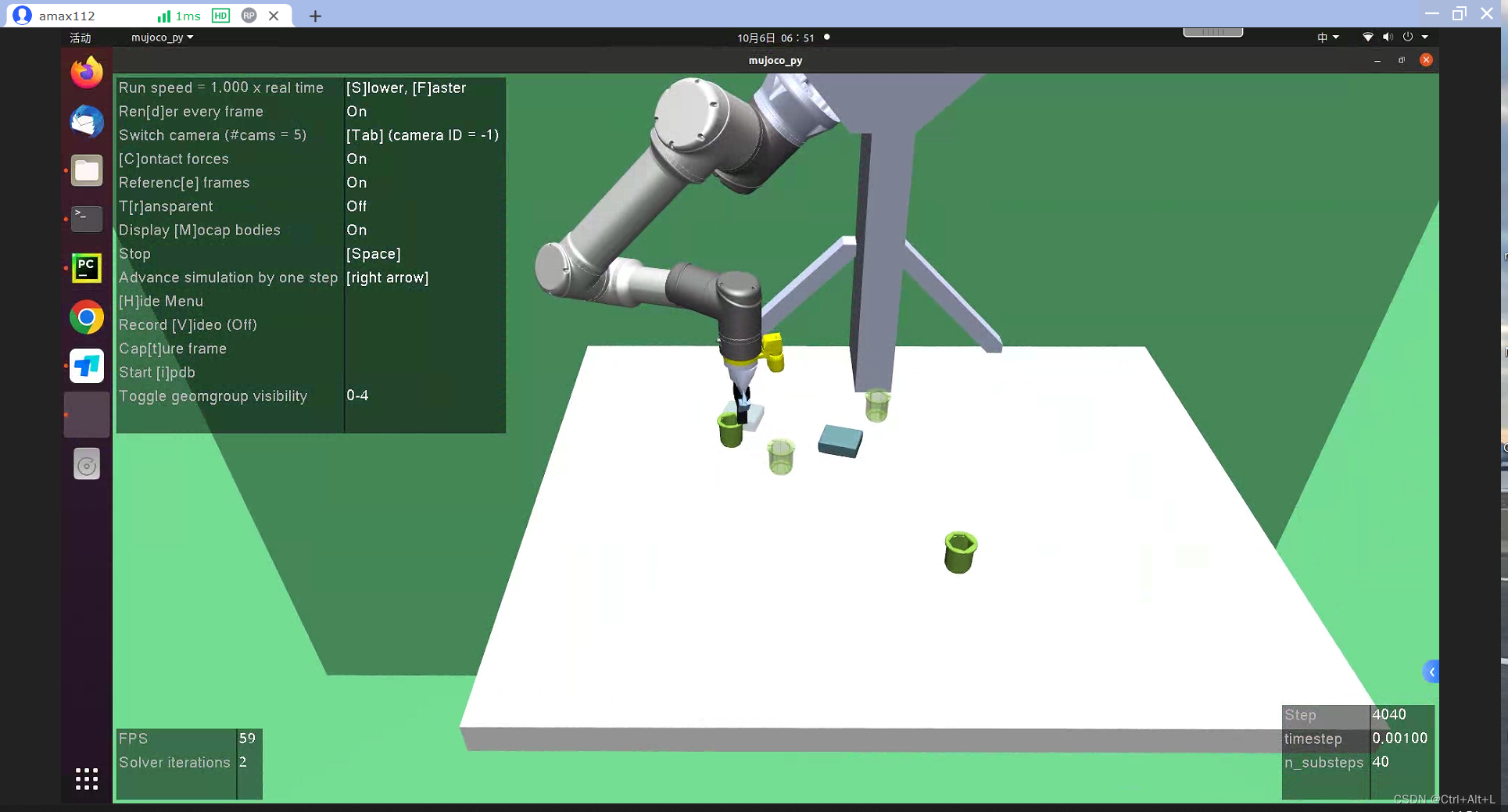
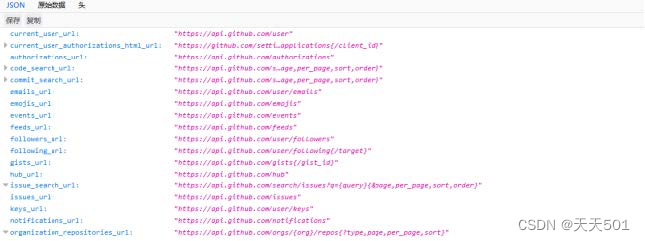
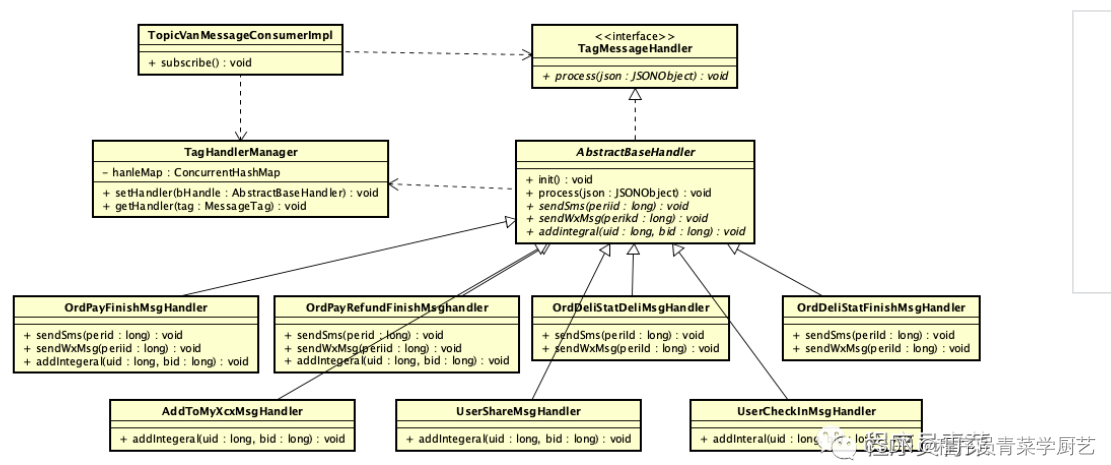


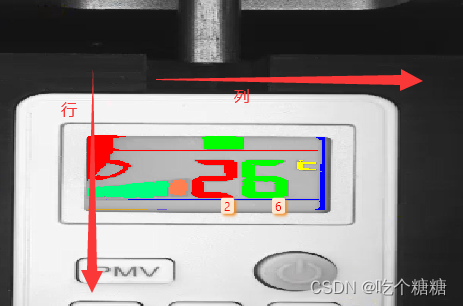



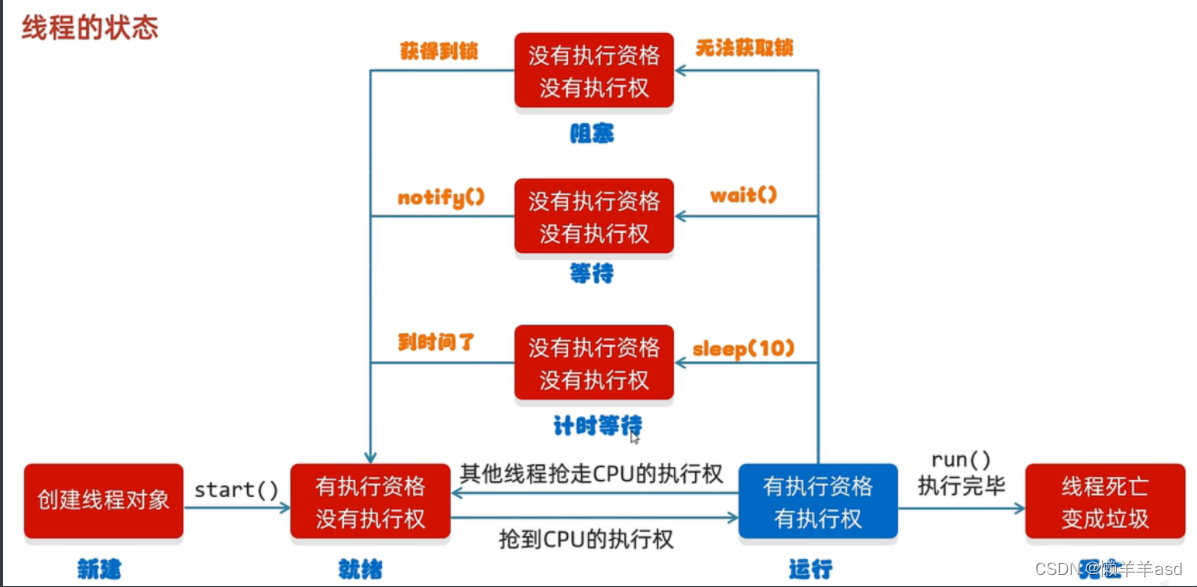
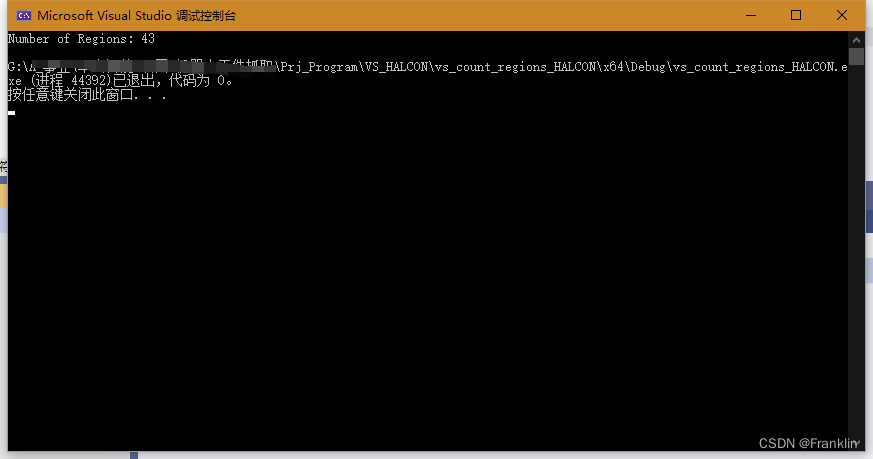
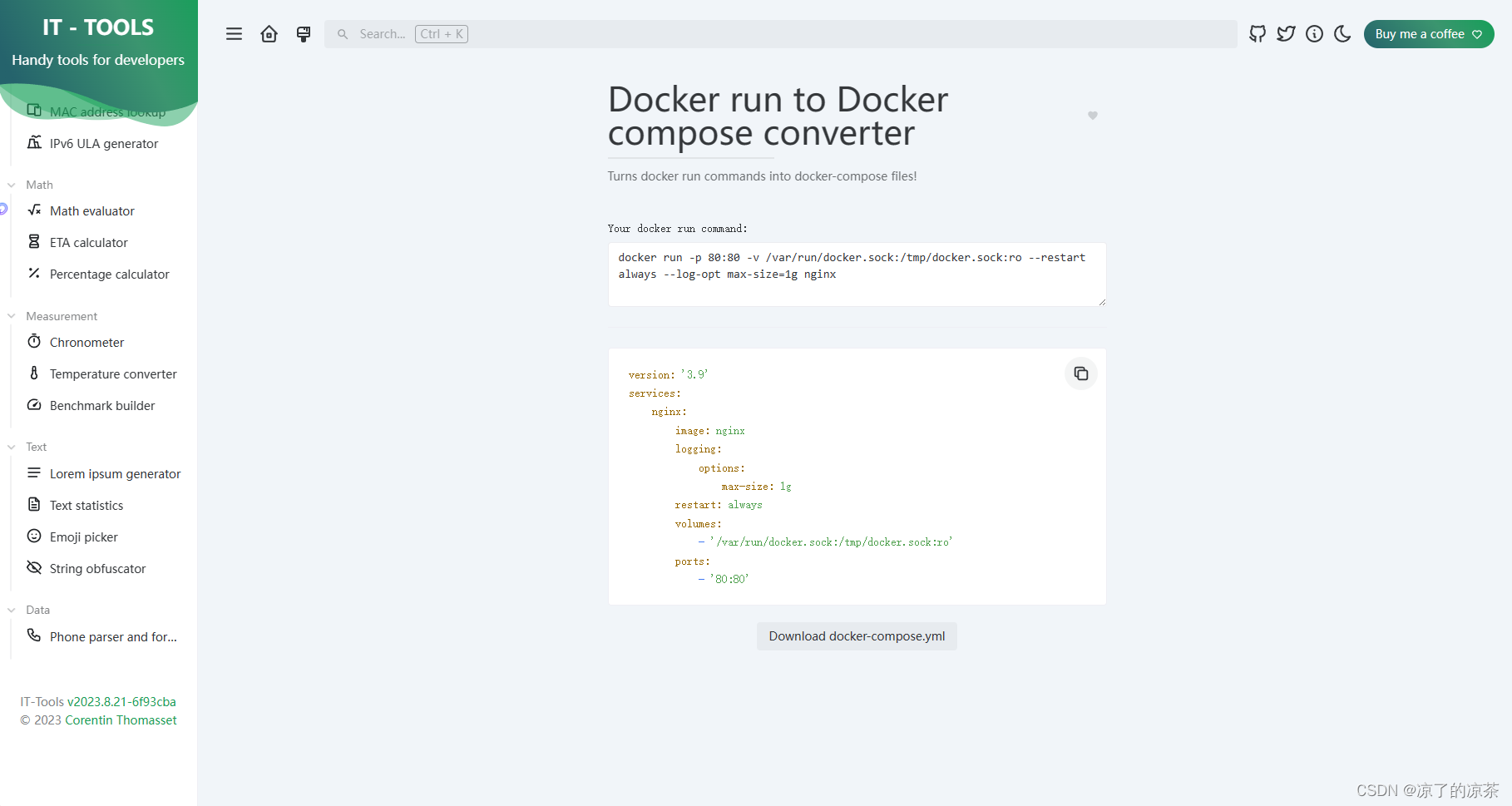
![[unity]保存文件的路径设置](https://img-blog.csdnimg.cn/02fc94df4ae44579b0051ad8b21e4bca.png)
